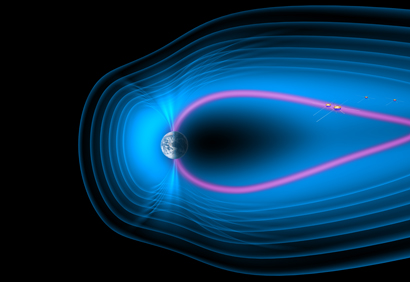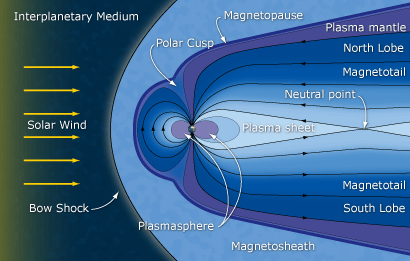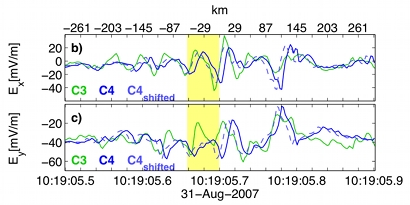Cluster looks into waves in the magnetosphere's thin boundaries
1 August 2012
Exploiting a favourable configuration of ESA's Cluster mission spacecraft, scientists have detected and characterised lower hybrid drift waves, a special kind of plasma waves that develop in thin boundaries both in space and in the laboratory. The measurement of fundamental properties of these waves was possible when two of the spacecraft were flying very close to one another in the tail of Earth's magnetosphere. With wavelengths of about 60 km, these waves appear to play an important role in the dynamics of electrons and in the transfer of energy between different layers of plasma in the magnetosphere.Like all planets with a magnetic field, Earth has a protective shield against the solar wind, the stream of charged particles released continuously by the Sun. This bullet-shaped bubble, called the magnetosphere, is forged by the interplay between the solar wind and our planet's magnetic field and is composed of plasma, a state of matter that consists of charged particles and ions rather than atoms or molecules. The shielding effect, however, is not complete: particles from the solar wind are able, under certain conditions, to leak into the magnetosphere, where they may be subsequently accelerated, giving rise to the spectacular phenomenon of aurorae.
 |
| Artist's impression of Cluster spacecraft flying through the thin boundary in the magnetotail. Credit: ESA/AOES Medialab |
The detailed mechanisms that cause solar wind particles to enter the magnetosphere and to be accelerated to high energies are not yet fully understood. More generally, the mutual interaction between the various regions that make up the magnetosphere, populated by plasma with very different densities and energies, remains an open issue and is the subject of extensive investigations. Understanding these processes is of great importance in the context of space weather, which is crucial to the operation of space missions and telecommunications networks. Besides, similar processes also take place, in a scaled-down version, when plasma is artificially produced in the laboratory for a variety of Earth-bound applications – an example is the tokamak plasma employed in nuclear fusion research. Earth's magnetosphere provides scientists with a giant testbed to study the behaviour of plasma on different scales than those that can be tackled in the laboratory.
In the magnetosphere, interactions are not a trivial problem, as plasma there is in a state referred to as 'collisionless' – the density and energy of particles and ions are such that individual collisions between them are extraordinarily rare. Therefore, the exchange of matter and energy between different plasma regions, as well as the acceleration of particles, must take place via mechanisms other than collisions. In fact, plasma has a very interesting feature that distinguishes it from an ordinary gas: while remaining neutral as a whole, local differences may develop in the distribution of its positive and negative charges. These inhomogeneities give rise to electric and magnetic fields and, in turn, the oscillations of such fields produce waves. Whereas particles in collisionless plasma hardly ever impact one another, they interact with these waves via the electromagnetic force and may gain or lose energy in the process.
In particular, theory suggests that electrons, which dominate the dynamics of plasma on small scales, are strongly affected by a special type of waves called lower hybrid drift waves. These waves are known to develop in plasma whenever its density and the strength of its magnetic field undergo an abrupt change. While these waves are well understood from a theoretical point of view, it has not been possible so far to fully characterise them experimentally, nor to probe their interaction with electrons. A new study based on data from ESA's Cluster mission has now shed light on the subject by measuring their wavelength and velocity in the magnetosphere.
"The small scales where lower hybrid drift waves are generated complicate the efforts to measure their properties," comments Cecilia Norgren, from the Swedish Institute of Space Physics, who is also a PhD student at Uppsala University, Sweden. Norgren is the lead author of the paper reporting on the study and published online on 31 July 2012 in Physical Review Letters. In the case of artificial plasma in the laboratory, measuring the wavelength and speed of these waves is practically impossible; the scales involved are of the order of a hundred microns or even less, and experimental probes are often of the same size, thus interfering with the measurement process. "Fortunately, the magnetic field strength in the Earth's magnetosphere is much weaker and lower hybrid drift waves arise on scales of a few tens of kilometres. This allows us to detect them by performing simultaneous measurements with multiple spacecraft, provided that the separation between them is also of the same scale," she adds.
 |
|
The different plasma regions that make up Earth's magnetosphere. Credit: ESA (adapted from picture courtesy C. Russel) |
Norgren and her collaborators examined data collected with the Cluster spacecraft as they flew through the magnetotail, the long, cylindrical end of the magnetosphere that extends in the direction opposite the Sun. The magnetotail comprises the lobes, two plasma layers characterised by very low density and strong magnetic fields, and a denser layer between them – the plasma sheet – where the magnetic field is weaker than in the lobes. The plasma sheet is separated from the lobes by a very thin boundary. "Due to the drastically different properties of plasma on either side of narrow boundaries such as the one in the magnetotail, we expect these sites to host most of the energy exchanges that take place in a plasma," explains Mats André from the Swedish Institute of Space Physics, co-author of the paper and Norgren's PhD supervisor.
The team of scientists exploited a very favourable crossing of the Cluster spacecraft through this region. During several months in 2007, the four spacecraft were arranged in an unusual configuration, with two of them separated only by a few tens of km, and the other two at a much larger distance. "When the two nearby spacecraft were both located in the thin boundary on 31 August 2007, their separation was only 40 kilometres: an ideal setup to probe the behaviour of plasma on the scales where electrons become dominant and to search for lower hybrid drift waves," André adds.
 |
| Lower hybrid drift waves detected with two of Cluster's spacecraft. Image courtesy of Cecilia Norgren, Swedish Institute of Space Physics and Uppsala University, Sweden |
Analysing the data, the team successfully detected such waves, measuring their wavelength, which is of the order of 60 kilometres, and propagation velocity, which is about 1000 kilometres per second. "The results represent the first detailed characterisation of lower hybrid drift waves in space and are in good agreement with theoretical expectations," notes Norgren. The velocity of the waves is of the same order as the typical velocity of ions in the magnetosphere plasma, as predicted by theory. "Furthermore, the electrostatic potential associated with the waves corresponds to about 10 per cent of the electron energy, suggesting that these waves may possess enough energy to have a strong impact on the dynamics of the electrons and to accelerate them," she adds.
The study by Norgren and her collaborators demonstrates that electrons do interact with lower hybrid drift waves and that this represents an efficient mechanism to transfer energy between different layers of plasma. Future studies will investigate this process in greater detail, trying to understand the role played by these waves in the context of magnetic reconnection.
"This study significantly improves our knowledge of the dynamics and energetics of plasma in the magnetosphere on the small scales governed by electrons," comments Matt Taylor, Cluster Project Scientist at ESA. Thus far, scientists had achieved a fairly good understanding of the magnetospheric plasma on very large scales, where it can be described in macroscopic terms, and on intermediate ones, dominated by ions, but the small-scale regime had remained less clear. "With this result, we have made a crucial step towards achieving an ever more detailed picture of our planet's magnetic environment," he concludes.
Notes for editors
The study presented here is based on data gathered by two of the four Cluster spacecraft (C3 and C4) on 31 August 2007, as they were flying through the plasma sheet boundary layer in the tail of Earth's magnetosphere. During this event, the separation between the two spacecraft was small enough (about 40 km) to measure the wavelength of lower hybrid drift waves, a particular type of plasma waves that develop in the presence of sharp discontinuities in the plasma density and magnetic field strength. The observed wavelength of these waves is about 60 km, and they appear to propagate with a velocity of about 1000 km/s.
Cluster is a constellation of four spacecraft flying in formation around Earth. It is the first space mission able to study, in three dimensions, the natural physical processes occurring within and in the near vicinity of the Earth's magnetosphere. Launched in 2000, it is composed of four identical spacecraft orbiting the Earth in a pyramidal configuration, along a nominal polar orbit of 4 × 19.6 Earth radii (1 Earth radius = 6380 km). Cluster's payload consists of state-of-the-art plasma instrumentation to measure electric and magnetic fields over wide frequency ranges, and key physical parameters characterising electrons and ions from energies of near 0 eV to a few MeV. The science operations are coordinated by the Joint Science Operations Centre (JSOC) at the Rutherford Appleton Laboratory, United Kingdom, and implemented by ESA's European Space Operations Centre (ESOC), in Darmstadt, Germany.
Related publications
C. Norgren, et al., "Lower hybrid drift waves: space observations", 2012, Phys. Rev. Lett., 109, 055001. DOI: 10.1103/PhysRevLett.109.055001
Contacts
Cecilia Norgren
Swedish Institute of Space Physics
and Uppsala University
Uppsala, Sweden
Email: cecilia.norgren![]() irfu.se
irfu.se
Phone: +46184715934
Mats André
Swedish Institute of Space Physics
Uppsala, Sweden
Email: mats.andre![]() irfu.se
irfu.se
Phone: +46184715913
Matt Taylor
Cluster Project Scientist
Research and Scientific Support Department
Directorate of Science & Robotic Exploration
ESA, The Netherlands
Email: mtaylor![]() rssd.esa.int
rssd.esa.int
Phone: +31-71-565-8009
C. Philippe Escoubet
Cluster Mission Manager
Research and Scientific Support Department
Directorate of Science & Robotic Exploration
ESA, The Netherlands
Email: Philippe.Escoubet![]() esa.int
esa.int
Phone: +31-71-565-3454


